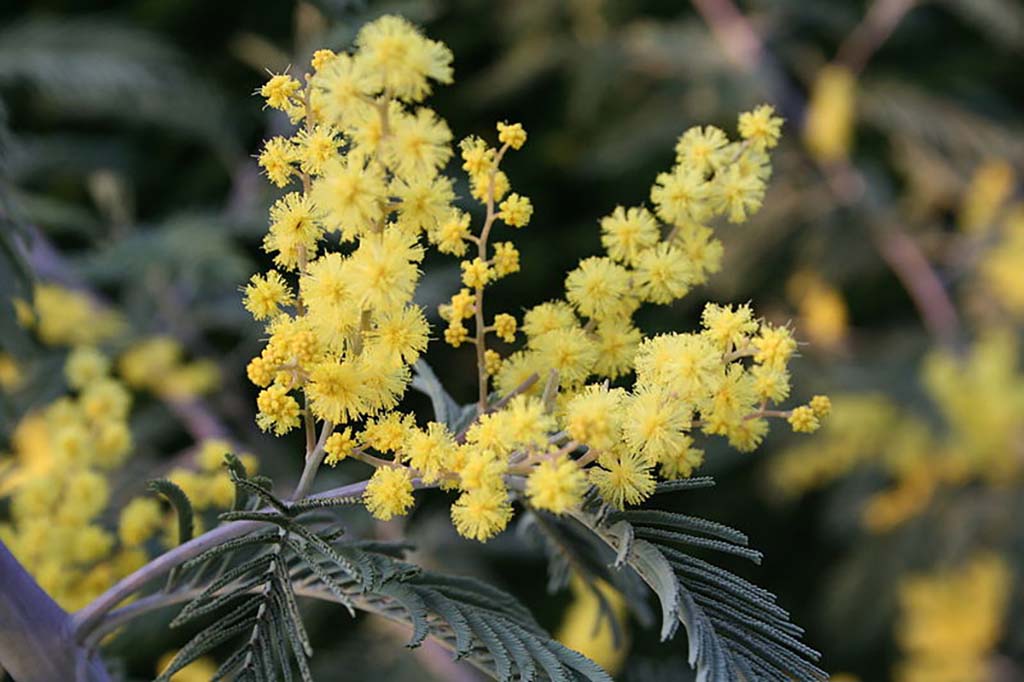
Mauritania
Acacia “Mimosa”
Acacia dealbata

General Description / Cultural Significance
The Islamic nation of Mauritania lies on the Atlantic coast of Africa and bridges western, Sub-Saharan Africa with the Maghrib region of North Africa. Most of Mauritania’s population was nomadic until drought conditions began to worsen in the 1970s, making life in the Sahara Desert, which constitutes most of the country, more difficult. The soil is mostly rocky or made up of sand dunes, and the arid, dry climate ensures that only vegetation particularly adapted to this environment can survive. The Acacia, Acacia dealbata, is a shrub-like evergreen tree that is in leaf all year, and is signature to the Sahel, the edge of the southern Sahara in Mauritania. Known also as Mimosa, the Acacia’s flowers can be cooked and are often used for their flavor and pollen density to make fritters. Yellow dye is extracted from the flowers while a green dye is reduced from the seed pods for both culinary and practical dying use. For thousands of years, Mauritanians tapped the trunks of the Acacia to extract the viscous, aromatic sap which comes from it. Rich, dark gum was used as an astringent and the lighter, sweet gum was chewed as candy or soaked in water to concoct a pleasant tasting jelly. The gum has also been traditionally consumed as a treatment for diarrhea and hemorrhoids. Tannins in the bark of the Acacia make it a particularly useful mouth wash and an astringent which has been used to mitigate internal bleeding and treat wounds
A very similar gum called Gum Acacia or Gum Arabic, extracted from two other Acacia species, has been used for similar versatility outside of Mauritania. Its use dates all the way back to the Egyptians who thickened their paints with it. Europeans imported Gum Acacia from the Sahara and used it to make paper, glue, and ink, while also including it for its stiffening properties in cosmetics and textiles. Centuries later, it was made famous for its role in what is known as the “Diet Coke and Mentos” eruption. In this 1999 televised science experiment, Mentos mints were added to carbonated Diet Coke to induce a spectacular explosion. Research revealed that it was the Gum Acacia in the mentos that produced this reaction. During this time, the gum spread throughout the globe, becoming well known as an emulsifier, stabilizer, and thickener in foods and beverages, and as a medical cure for high cholesterol, diabetes, and digestive issues.
Exporting Gum Acacia was a major enterprise in Mauritania during this time. However, the droughts of the 1970s fractured the Acacia populations so badly that production plummeted, and the industry and ecosystem was all but destroyed, never to return to its past productivity. Today, there are efforts to restore the Acacia and the gum it produces. This prospect holds the key for Mauritania to revitalize its degraded ecosystems.
Climate Change / Conservation Status
Mauritania has experienced most of its climate change through desertification. As a result of this process, dryland is degraded and vegetation is reduced, a phenomenon affecting the greater sub-Saharan region at large. Climate induced droughts, changing wind patterns, and human extraction all play a role in how this is affecting Mauritania and the Acacia. The exploitative harvesting of Acacia trees of all species is rendering Mauritania’s soil unable to hold sufficient water. This leaves the land vulnerable to erosion, in turn escalating the desertification already present due to climate change.
Just a half a century ago, Acacia trees grew in dense forests throughout the southwestern parts of Mauritania. Today, these once lush areas have been buried in sand dunes. Various organizations are investing in the regeneration of Acacia forests in the hopes that the drought-resistant trees will revitalize the land and, eventually, add a source of sustainable economy back for rural Mauritania communities. On the coast, Mauritania is also looking towards trees for their strength. As most of the capitol is at or below sea level, the country has launched a tree-planting program to protect the city from advancing dunes and coastal erosion, effectively forming a green belt of trees like Acacia dealbata. The Acacia is also a powerful carbon sequester, meaning it traps harmful carbon dioxide, removing it from the atmosphere. The country is now being compensated for the role its newly planted Acacia forests have played in sequestering hundreds of tons of carbon dioxide since 2007.
Through its Gum production, robust protective abilities, medicinal properties, and ability to trap carbon dioxide, the Acacia is truly Mauritania’s path towards a more sustainable economy and a healthier ecosystem and people. There is no other tree better to follow into a brighter future than the Acacia which Mauritanians have built their livelihoods, medicine, food, and lives around for centuries.
Alternate Names
Mimosa
Silver Wattle
Sources
Boussery, M., 2022. Fighting back the desert in Mauritania. MDGFund. [website]
Burdock, G.A., 2014. Encyclopedia of Food & Color Additives, CRC Press. [website]
Diarra, S., 2020. The ancient trade holding back the Sahara Desert. BBC. [website]
Fern, K., 2021. Acacia dealbata. Useful Temperate Plants Database. [website]
IFAC, 2022. Gum Arabic. International Food Additives Council. [website]
Muir, H., 2008. Science of Mentos- Diet Coke Explosions Explained. ABC News. [website]
Natural Herbs, 2022. Mimosa: Acacia dealbata. Natural Herbs. [website]
Toupet, C. H., 2022. Mauritania. Encyclopedia Britannica. [website]
UNDP, 2022. Mauritania. United Nations Development Programme. [website]
Webb, J.L., 1985. The trade in Gum Arabic: Prelude to French conquest in Senegal. The Journal of African History, 26(2), pp.149–168.
WebMD, 2022. Gum Arabic Uses, Side Effects, and More. WebMD. [website]
World Bank, 2016. Gum Arabic Supports Green Growth in Mauritania. The World Bank. [website]

